Abstract
The projected increase in the availability of gaseous fuels by growing popularity of household natural gas (NG) filling stations and the increase in the production of gaseous biogas-derived fuels is conducive to an increase in the use of NG fuel. Currently, natural gas in various forms (compressed natural gas (CNG), liquefied natural gas (LNG)) is popular in maritime, rail and road transport. A new direction of natural gas application may be non-road mobile machines powered by a small spark-ignition engine (SI). The use of these engines in the wood chippers can cause the reduction of machine costs and emissions of harmful exhaust gases. In addition, plant material chippers intended for composting in bio-gas plants can be driven by the gas they are used to produce. The biogas can be purified to bio-methane to meet natural gas quality standards. The article presents the design of the natural gas supply system, which is an upgrade of the Lifan GX 390 combustion engine spark ignition engine (Four-stroke, OHV (over head valve) with a maximum power of 9.56 kW), which is a common representative of small gasoline engines. The engine is mounted in a cylindrical chipper designed for shredding branches with a maximum diameter of up to 100 mm, which is a typical machine used for cleaning work in urban areas. The engine powered by CNG and traditionally gasoline has been tested in real working conditions, when shredding cherry plum (Prunus cerasifera Ehrh. Beitr. Naturk. 4:17. 1789 (Gartenkalender4:189–204. 1784)). Their diameter was ca. 80 mm, 3-metere-long, and humidity content ca. 25%. The systems were tested under the same actual operating conditions, the average power generated by the drives during shredding is about 0.69 kW. Based on the recorded results, it was found that the CNG-fuelled engine was characterized by nitrogen oxides (NOx) emissions higher by 45%. The other effects of CNG were a reduction in carbon dioxide (CO2), carbon monoxide (CO) and hydrocarbon (HC) emissions of about 81%, 26% and 57%, respectively. Additionally, the use of CNG reduced fuel consumption by 31% and hourly estimated machine operating costs resulting from fuel costs by 53% (for average fuel price in Poland: gasoline: 0.99 EUR/L and CNG: 0.71 EUR/m3 on 08 November 2020). The modernization performed by the authors ensured the work of the drive unit during shredding, closer to the value of stoichiometric mixtures. The average (AVG) value of the air fuel ratio (AFR) for CNG was enriched by 1.2% (AVG AFR was 17), while for the gasoline engine the mixture was more enriched by 4.8% (AVG AFR was 14). The operation of spark-ignition (SI) combustion engines is most advantageous when burning stoichiometric mixtures due to the cooperation with exhaust aftertreatment systems (e.g., three-function catalytic converter). A system powered by CNG may be beneficial in systems adapting to operating conditions, used in low-power shredding machines, whose problem is increased HC emissions, and CNG combustion may reduce them. The developed system does not exceed the emission standards applicable in the European Union. For CO emissions expressed in g/kWh, it was about 95% lower than the permissible value, and HC + NOx emissions were 85% lower. This suggests that the use of the fuel in question may contribute to tightening up the permissible emission regulations for non-road machinery.
1. Introduction
Natural gas (NG) is an alternative fuel within the meaning of the European Union Directive (2014/94/UE), as it is an alternative for energy sources derived from crude oil [1].
It is used in many forms for driving internal combustion engines, e.g., NG, compressed natural gas (CNG) and liquefied natural gas (LNG) [2,3]. The main component of NG is methane (CH4) (usually ≥90%), in addition, small amounts of ethane, propane, butane and other organic and mineral compounds may be present [4]. Due to the relatively high amount of CH4 in NG (e.g., in Poland it is 98%), the designs with methane supply are also worth analysing.
The use of NG for driving internal combustion engines is an innovative development trend in many industry branches. Mainly in maritime and rail transport in the form of LNG and road transport in the form of CNG. Some of the work in this area of knowledge is directed towards the replacement of traditional fuels (gasoline or diesel) by CNG. The second group of ongoing activities explores the impact of NG blends added to traditional fuels. Another group of researchers are analysing the impact of hydrogen H2 blends in CNG.
Studies on the emission of harmful exhaust gas compounds in public transport buses fuelled with diesel or CNG under actual operating conditions have shown that CNG buses may have a reduction of CO2 by 6% and NOx by 90% [5]. On the other hand, they are characterized by higher emissions of CO by 45% and total hydrocarbon (THC) by 156% [5]. The research on the fleet of vehicles adapted to waste collection in urban areas has shown that vehicles fuelled with CNG have reduced CO2 emission and energy consumption [6] in comparison to traditional fuels (gasoline, diesel oil). Comparative research of the SI engine fuelled with gasoline and CNG showed that the application of CNG reduced the driving power by about 12–30% [7,8,9,10,11,12,13]. One aspect is the reduction in the volumetric efficiency of CNG-fuelled engines due to the larger percentage of air in CNG by volume. Lower torque and power were reported as a result of lower or leaner fuel (CNG) injection per cylinder. Average brake mean effective pressure and brake-specific fuel consumption (bsfc) for CNG were lower than that of gasoline owing to the higher heating value of CNG [7]. This property also exhibited an increase in the net thermal efficiency of the engine [14]. Furthermore, the emissions of harmful HC combustion gases were lower by 57%, CO by 43%, CO2 by 19% and NOx by 20%. Additionally, the authors demonstrated that the engine operation on CNG fuel deteriorates the lubricating oil properties [7]. The research carried out in China on automotive vehicles has shown that compressed (CNG) and liquefied (LNG) gaseous fuels allow to reduce the emission of carbon to the atmosphere by about 10% in comparison to gasoline vehicles [15]. A review of research conducted on vehicles in road transport shows that the use of CNG can bring benefits in terms of reducing toxic emissions. However, this reduction does not have to apply to all the emitted exhaust gas compounds, and these parameters may change with the operating time and the fuel system wear level [2,3].
Natural gas in the form of liquid LNG is the fuel of choice for long-distance maritime transport and heavy rail transport, where it is considered a low-emission fuel [16]. The use of this fuel requires special fuel supply facilities [16,17] as it is a cryogenic fuel with a boiling point of approximately 120 K (−153 °C) [16]. LNG is a popular fuel for sea vessels due to its low cost and environmental friendliness [18]. This fuel in maritime transport is a transitional fuel in the decarbonisation of maritime transport [19]. In ship engine designs, the use of LNG fuel may limit NOx [20]. However, the level of NOx emission is strongly related to the efficiency level of the drive unit [20]. Other studies on LNG-powered ships show a reduction in fuel consumption, CO2 and NOx emissions compared to traditional fuel (diesel), while at the same time causing higher HC emissions than traditional fuels [21]. Tests of engines with LNG fuel installations show that they can reduce exhaust emissions.
Tests are also carried out on diesel and CNG blends for diesel particulate matter emissions (diesel share between 70% and 85%). Depending on the operating conditions, the use of CNG additives reduced engine smoke from 10% to 92% and the total number of particulates from 30% to 40% [22]. Other research on compression-ignition (CI) engines shows that NG additives reduced CO2 emissions from 17% to 20%, but increased CO and HC emissions at the same time. In addition, it also reduced NOx emissions by 60% to 82% and smoke by 23% to 39% [23]. Innovative research directions on the supply of CNG spark-ignition internal combustion engines are directed towards hydrogen admixtures, creating HCNG fuels with hydrogen addition [24]. Research shows that the right proportion of hydrogen and CNG can reduce the emission of harmful exhaust gas compounds (CO, CO2, HC, NOx) [25] or keep it at a convergent level [26] in relation to petrol or CNG engines while maintaining similar torque characteristics [25].
The term “small engines” concerns spark ignition (SI) engines in terms of their use in wood chippers with a power not exceeding 19 kW [27,28]. Regulations concerning nonroad mobile equipment with compression-ignition (CI) engines apply to engines without defined restrictions of the power of the drive unit. However, they introduce a division into various research cycles, which depend on the engine power [27]. Among the innovative applications in these drive units, electronic fuel supply systems can be included [29,30,31], as the liberal regulations concerning exhaust emissions, e.g., in the European Union (Regulation 2016/1628/EU), allow the use of carburetor power systems [28]. Other innovations relate to adaptive systems for operating conditions combined with systems regulating the supply of fuel-air mixture to the combustion chamber [32,33,34,35,36] or alternative fuels (e.g., liquefied petroleum gas (LPG)) [37,38,39,40,41,42,43], ethanol [44,45], methanol [46]). The authors noted the lack of articles describing the modernization of the design enabling the use of CNG fuel in small spark ignition (SI) engines. The authors’ solution is designed in such a way that it may constitute a modernisation module of the drive units available on the market. Commercial small engines characterized by the most advanced fuel supply system, electronically controlled, is a model produced by Honda: iGX 390. This unit in Europe is about four times more expensive than engines produced by Chinese and Indian manufacturers under a Honda license, with the traditional fuel supply system (carburetor) [47]. Emissions regulations in Europe are not conducive to a reduction in this type of power unit. That is why the authors have undertaken works to modernise a unit that does not require an electronic control unit by adapting the carburetor to gaseous fuels. Such a solution is characterised by lower costs and, according to the authors, it is more ready to be implemented on the market. The authors performed tests of engines powered by gasoline and CNG in real working conditions. “Gasoline” refers to non-lead petrol as a flammable liquid that is mainly used as a fuel in most spark-ignited internal combustion engines, with a value of 95 octane number. They have compared the emissions of harmful exhaust gases, referred them to emission regulations, determined fuel consumption and assessed the operating costs in terms of the cost of the fuel used. They described the modernisation and determined its costs. The tests of the emission of harmful exhaust gas compounds are described in the global trend of testing the impact of machines on the environment and surroundings under real working conditions. Such tests were carried out for high power shredding machines (180 kW–600 kW) [48,49,50] and low power shredding machines (less than 10 kW) [32,43]. The authors see the possibility of increasing interest in and applications for the development of gaseous fuel supply systems in internal combustion engines, to which the increasingly common biogas plants [51] (increase in types of biodegradable materials [52,53,54]) and household filling stations [55] may contribute.
2. Materials and Methods
During the research a Red Dragon RS-100 wood chipper was used (Remet CNC Technology Sp. Z O.O., Kamień, Poland), which is presented in Figure 1a. This machine can be considered a typical one, which is commonly used for grinding wood material in urban areas. The technical specification of this chipper is presented in Table 1. The chipper with the factory settings (A) was driven by the spark-ignition (SI) engine Lifan GX390 (License: American Honda Motor Company, Inc., Torrance, CA, USA), 9.5 kW (Figure 1b). The tested drive unit technical specification is shown in Table 1, while its characteristics concerning fuel consumption as well as power and torque are presented in Figure 2a. This engine efficiency characteristics were determined on the basis of input and output energy and are presented in Figure 2b. As a result of the carried out works, the original machine was modernized to the second version (B). In version (B) the gasoline-powered carburetor was replaced by a carburetor system adapted to the use of natural gas. The modified, natural gas-powered carburetor is presented in Figure 1c. The carburetor adapted to natural gas could be supplied in two configurations: from a household gas installation—At a pressure not lower than 0.01 MPa (Figure 1f). In the case of the installation available to the authors, the gas pressure was 0.002 MPa, therefore the fuel supply system was replaced by a system adapted to CNG (Figure 1e). Such a solution involved the need to expand the gas from the cylinder in which it was stored at a pressure of 20 MPa. The gas expansion from 20 MPa to 0.6 MPa led to freezing of the first-stage regulator, so a gas heater was used between the cylinder’s valve and the regulator to ensure proper operation of the first-stage regulator. Then a second stage regulator was used to reduce gas pressure from 0.6 MPa to 0.01 MPa. The gas pressure of 0.01 MPa made it possible to supply enough fuel to achieve the operating conditions ensuring full power of the combustion engine. The authors selected this value by checking the composition of the fuel-air mixture. Namely, if, as the load increased, the mixture became poorer and the introduced fuel dose control in the carburetor did not change the AFR value, it meant that the pressure on the second-stage regulator reduced the required fuel dose. If under full load the engine could operate with the enriched mixture, it meant that the amount of fuel supplied is not limited by the second-stage regulator. In the group of small engines, a CNG fuel supply system is an innovative solution and it is commercially available as a modernization possibility. The most essential components in combination with their costs required for the modernization of the gasoline engine are presented in Table 2. The designs (A) and (B) were both adjusted before the tests following the rules of regulating the tested carburetors for stoichiometric mixtures (AFR). For gasoline-powered engine (A) the AFR value was 14.7:1, while for CNG-powered design (B) it was 17.2:1. As part of the research, the emission level of selected harmful exhaust gas compounds was compared, which included: carbon dioxide CO2, carbon monoxide CO and hydrocarbon HC as well as nitrogen oxides NOx. This required conducting experiments on both designs (A) and (B) in real operating conditions. The tests concerned shredding branches with a maximum diameter of up to 100 mm. The size of the wood material used resulted from the strength of the cutting mechanism and the safety of machine operation. Table 3 presents the characteristics of the fuels used to power the engines during the tests.
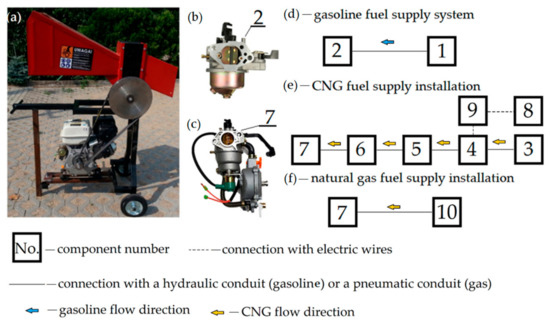
Figure 1.
The tests were performed on (a) a wood chipper with branch logger mechanism; (b) a gasoline adapted carburetor system; (c) a carburetor system adapted to natural gas and CNG; (d) a gasoline fuel supply system, where: 1—fuel tank, 2—gasoline carburetor; (e) CNG fuel supply system, where: 3—high-pressure tank (20 MPa), 4—gas heater, 5—first-stage regulator (from 20 MPa to 0.6 MPa), 6—second-stage regulator (from 0.6 MPa to 0.01 MPa), 7—natural gas and CNG carburetor; 8—DC converter from 12 V to 230 V AC; 9—12 V battery (f) natural gas fuel supply system, where: 10—household gas installation (minimum pressure 0.01 MPa).

Table 1.
Technical specification of Red Dragon RS-100 wood chipper and Lifan GX390 engine.
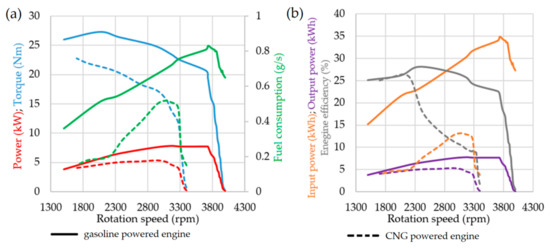
Figure 2.
Characteristics of the Lifan iGX 390 engine powered by gasoline and CNG, in terms of (a) power, torque, fuel consumption and efficiency; (b) efficiency, energy input and energy output. The colors refer to the individual physical quantities, and the line type to the fuel type.

Table 2.
Cost of components and services for modernizing a small CNG engine (costs relate to the Polish market in 2020).

Table 3.
Properties of tested fuels, where MON = motor octane number; RON = research octane number [57,58,59,60].
The cherry plum timber was selected for the tests (Prunus cerasifera Ehrh. Beitr. Naturk. 4:17. 1789 (Gartenkalender 4:189–204. 1784)). During the experiment branches with a diameter of ca. 80 mm and a length of 3 m were shredded. Their moisture content was checked before and during the tests and was about 25%—A METTLER TOLEDO HR83 moisture analyzer (Mettler Toledo, Columbus, OH, USA) was used for this purpose. Branches of similar dimensions were selected in order to standardize the conditions of the experiment. This provided a similar machine load and uniform shredding time, which for this kind of branch was about 4.5 s [26]. Shredding of such material generates a relatively high load (work near maximum permissible load values) on the cutting mechanism. The tested branches can be considered typically representative of hardwood species in accordance with the Janka classification [61]. The Janka hardness test measures the resistance of a sample of wood to denting and wear. It measures the force required to drive a steel drive 11.28 mm (0.444 in) diameter halfway into a sample of wood [62,63]. During the experiment, the branches were delivered to the chipper by one experienced operator from a pile 1 m away.
In order to confirm the convergence of the machine working conditions when driving with different fuel supply systems, the parameters of drive unit load and speed values were recorded. Diagram of the test station is presented in Figure 3. The station consists of a tested engine connected via a 1:1 ratio link transmission with a torque measuring shaft (by Pracownia Elektroniki Roman Pomianowski, Poznań, Poland) recording the torque and speed. Due to the fact that the torque measuring shaft should not be loaded with a bending torque, which may be caused by the link transmissions, countershafts have been mounted between the link transmission and the torque measuring shaft. The countershaft behind the torque measuring shaft is connected to the transmission (5:1), which transmits the torque in accordance with the ratio used in the factory machine. The recorded torque value describes the engine load after considering the efficiency of the system between the torque measuring shaft and the engine.

Figure 3.
The view of the test station: 1—test engine, 2—active pulley , 3—passive pulley , 4—pulley (ratio 1:1), 5 and 9—intermediate shaft, 6 and 8—clutch with a susceptible insert, 7—torque measuring shift with speed measurement, 10—active pulley , 11—flywheel , 12—link transmission (ratio 5:1), 13—wood chipper, 14—portable emissions measurement system (PEMS). In the system the relationship is maintained.
The torque measuring shaft is mounted according to the manufacturer’s recommendations by means of clutches with a certain degree of flexibility. This is to ensure safe operation. In the presented system there are mechanical losses caused by friction in rolling elements, elastic couplings’ susceptibility and belt transmission efficiency. The influence of twisting of countershafts has been omitted in the tests, because their rigidity is much higher than the aforementioned elements. The total mechanical efficiency of the system is given by formula (1):
where: is the efficiency of rolling bearings, is the efficiency of the clutch, is the efficiency of the link transmission. The mechanical power in the system as measured by the torque measuring shaft is related to the mechanical power on the motor shaft as described by Equation (2):
The mechanical power values can be defined as relationships (3):
where: is the torque measured by the torque measuring shaft, is the angular speed measured by the torque measuring shaft, is the speed measured by the torque masuring shaft, is the torque developed by the engine, is the engine angular speed and is the engine speed. After considering the slip, using the (4) belt slip rate:
and Equations (2) and (3) the relationship of torques can be written as (5):
The values used in the calculation are shown in Table 4.

Table 4.
Values used to calculate the test station efficiency [64,65,66,67].
Axion RS+, a typical portable emissions measurement system (PEMS) from Global MRV, was used to test exhaust emissions. Table 5 presents its technical specification. In the research emission, levels of hydrocarbon (HC), carbon monoxide (CO), carbon dioxide (CO2) and nitrogen oxides (NOx) were analyzed. Fuel consumption was determined on the carbon balance [68]. The measuring device used in the experiments carried out the measurement of concentrations expressed in vol.% or ppmv. As a result, more measurable emissions were determined. The emission value was calculated on the basis of the measured concentrations of the tested chemical compounds and the measurement of the air mass supplied to the combustion chamber by measuring the pressure in the inlet manifold.

Table 5.
Characteristics of Axion RS, a portable exhaust emissions analyzer [68].
3. Results
3.1. Work Conditions
Comparison of exhaust emissions and fuel consumption under real work conditions should be made under similar operating conditions. During the tests, the torque value (Figure 4) and rotational speed (Figure 5) were recorded. Based on these measurements, the measured values were recalculated using relationships (2), (3) and (5), and then, according to Equation (6), the power generated by the drive during the shredding process was determined (Figure 6). Changes in these values as a function of time are due to system loading. The torque value can be interpreted as the torque generated by the internal combustion engine; however, it should not be interpreted as the torque value necessary for shredding the branches (from which the cutting force can be calculated [69,70,71]), as the measurement takes place in front of the chipper flywheel, which increases the cutting force.
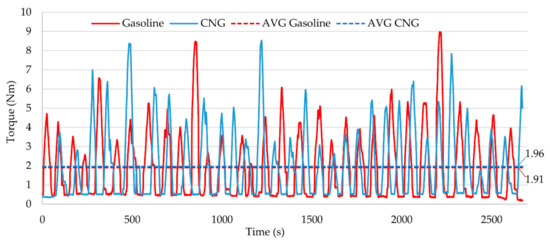
Figure 4.
Torque value during the shredding process.
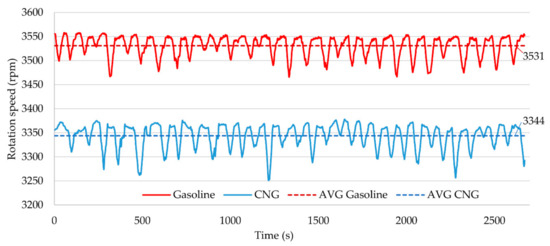
Figure 5.
Rotational speed value during the shredding process.
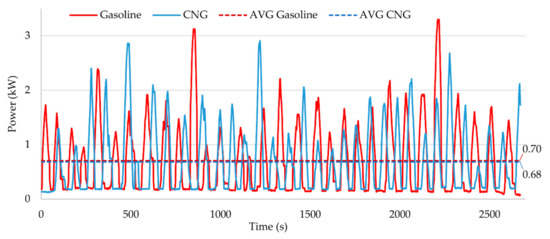
Figure 6.
Power during the shredding process.
3.2. Harmful Exhaust Gas Emissions
Figure 7, Figure 8, Figure 9, Figure 10 show the results of the hourly emissions of harmful exhaust gas compounds measured during the experiments (CO, CO2, HC, NOx respectively). They also contain fuel consumption level of both gasoline-powered and CNG-powered engines. The mentioned characteristics are a function of time and were recorded during the chipping process. Higher changes in the instantaneous emission value for an CNG-powered engine can be observed for all harmful compounds. These instantaneous changes (visible as sudden jumps in value) result from differing engine loads and are caused by supplying branches to the chipper feeding channel. It can be concluded that emissions from the CNG-powered engine shows a greater susceptibility to variation in load.
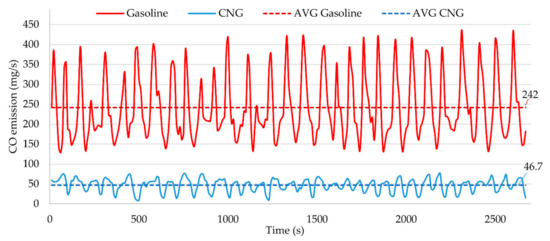
Figure 7.
CO emission as a time function during the shredding process.
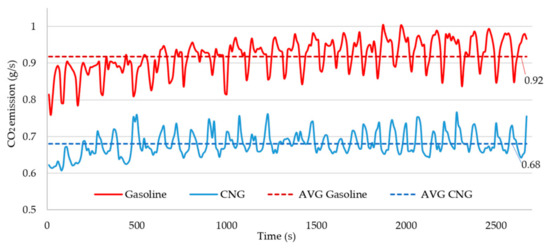
Figure 8.
CO2 emission as a time function during the shredding process.
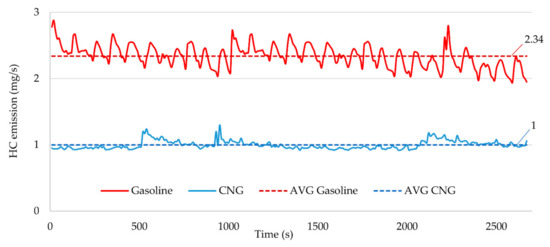
Figure 9.
HC emission as a time function during the shredding process.
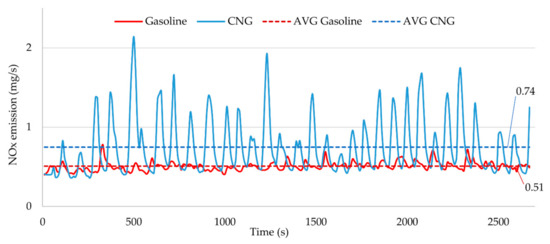
Figure 10.
The emission of NOx as a time function during the shredding process.
3.3. Composition of the Fuel-Air Mixture
Air-fuel ratio (AFR) characteristics concerning the duration of shredding processes is shown on Figure 11. It is impossible to compare directly the gasoline-powered and CNG-powered engines. This is due to different AFR values for the stoichiometric mixtures of these fuels, which are 14.7 and 17.2 for gasoline and CNG, respectively. Nevertheless, the tested engines individual nature of work can be observed. Under the operating conditions, during tests, the gasoline-powered engine had a rich mixture and maintained it at a relatively stable level, differing from the average AFR value (AVG ≈ 14) by about 10%. On the other hand, the CNG-powered engine had a slightly enriched mixture (AVG ≈ 17), which was also maintained at a relatively stable level. However in the second case, the average AFR value deviated by about 2.5% from the stoichiometric mixture. This indirectly contributes to the higher efficiency of this engine, as shown in Figure 2b, because the supplied fuel was almost completely burned and converted into energy.
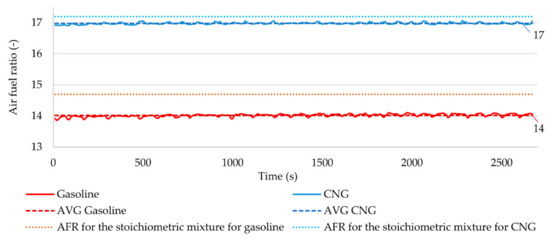
Figure 11.
Air-fuel ratio (AFR) characteristics for the engine powered by gasoline and CNG.
3.4. Fuel Consumption and Efficiency
Measuring fuel consumption is an important aspect in assessing the cost of machine use. The results of fuel consumption tests are presented in Figure 12. It can be noted that an engine running on gasoline is less susceptible to fuel consumption characteristics oscillation than an engine running on CNG. Additionally, the input energy supplied to the engine can be determined from the fuel consumption (Figure 13). Based on the information on the input and output energy determined from the power measurement (Figure 6), the efficiency of the drive units during the chipping processes (Figure 13) can be calculated. It can be noticed that the CNG-powered engine has an average efficiency of about 5.1% under the tested operating conditions, and the gasoline-powered engine was characterized by an efficiency of 3.8%. The CNG-powered engine is approximately 34% more efficient than the gasoline-powered engine.
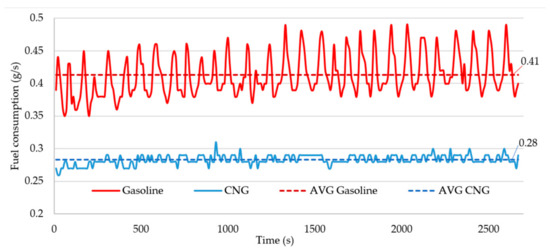
Figure 12.
Fuel consumption as a time function during the shredding process.
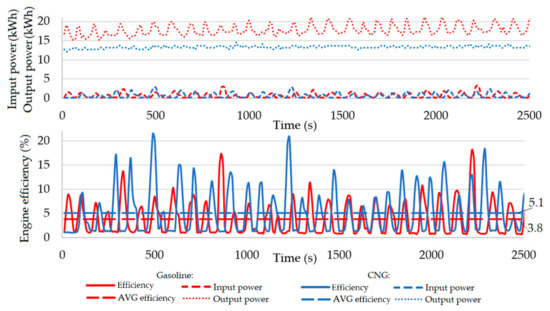
Figure 13.
Input and output energy and efficiency of the drive unit during chipping processes.
4. Discussion
In order to control efficiently the drive unit and to evaluate the reaction of the tested design to changes in the operating conditions, the emission of the generated exhaust gas compounds as a time function should be measured. The results may show areas that need improvements in the design. The results of exhaust emission tests over a specified period of time should also be considered important. These characteristics are presented in Figure 14 along with the average values. They provide information on the influence of selected machines on global or local exhaust emissions, thus allowing their comparison. Such a comparison (for gasoline and CNG) is presented in Figure 14 and Figure 15 on a percentage scale calculated according to Equation (7):
where: is the selected value for the gasoline fuel supply system, is the selected value for the CNG fuel supply system. Equation (7) is written in such a form that drops in the value are positive and increases in the value are negative.
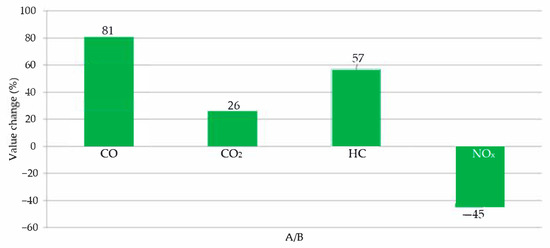
Figure 14.
Influence of the fuel supply system on selected values of exhaust emissions, where: A—gasoline fuel supply system, B—CNG fuel supply system.
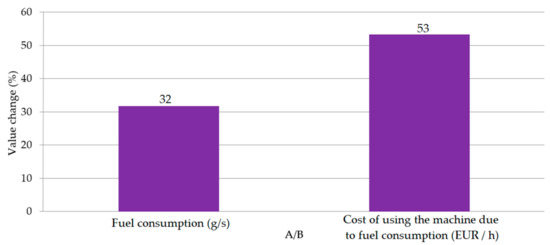
Figure 15.
Influence of the fuel supply system on selected values of fuel consumption and the costs of using the machine resulting from fuel consumption, where: A—gasoline fuel supply system, B—CNG fuel supply system.
The use of CNG installations reduced harmful emissions of exhaust gases: CO by 81%; CO2 by 26%; and HC by 57% compared to the engine with the classic gasoline carburetor system. The benefits obtained are consistent with the results of other researchers who have modernized internal combustion engines in other branches of industry, which are usually characterised by a much higher capacity and are subject to different exhaust emission regulations, most often more stringent, which was connected with higher technical advancement of these drive systems. Among the available test results one can observe the reduction of some chemical compounds and the growth of others. A common effect of the change of fuel from gasoline to CNG, coinciding with the results of the authors’ research, is the reduction of CO2 [5,6,7,72], CO [7,73] and HC [7,72,73,74,75]. CNG is composed of lighter hydrocarbons, and the ratio of hydrogen to carbon in CNG is much higher than in gasoline. This affects the combustion process in the cylinder, reducing the proportion of incomplete combustion, hence lower CO and HC emissions. On the other hand, the reduction of CO2 is mainly related to the reduction in fuel consumption. The disadvantage of the solution applied by the authors is the increase in NOx emissions by 45%. Organic NOx emissions after a fuel change is characteristic for CI engines [5,73,75,76]; however, they are often characterised by an increase in other combustion components. In SI engines an increase in NOx is noticeable with a decrease in other emissions [72,73]. The increase in NOx emissions in a CNG-fuelled engine is due to the higher maximum temperatures in the engine cylinder during combustion. As described above, it is also the cause of the reduced emission of incomplete combustion products HC and CO. Such a phenomenon can be reduced by enrichment of CNG with hydrogen. Tests of the SI engine powered by HCNG have shown the reduction of all 4 emissions at the same time (CO, CO2, HC, NOx) [7], hence this may be another direction of development of the tested design. Natural gas and hydrogen mixture combustion should intensify the lean-burn traits as well as lower some of the harmful emissions, such as CO, HC and CO2. The main issue, however, is the expected increase in NOx emissions [77,78]. Employing an NG/H2 mixture as a fuel can be profitable as it will take advantage of the positive aspects of hydrogen combustion. At the same time, the application of such a mixture does not require substantial alterations to the already existing natural gas engines [77,79]. The use of hydrogen inclusion as a complement to natural gas will boost the lean-burn limit to the hydrogen’s extended flammability range. Lean-burn ability enhances the thermal efficiency while at the same time decreasing the combustion temperature and the emission of NOx [77,80,81]. It also decreases the knock coincidence, which is a phenomenon that can lead to serious damage to the SI engine. The tested drive unit was analysed by the authors in another study—after modernisation of the fuel supply system supplying liquefied petroleum gas (LPG). The drive unit tested there, fuelled with LPG under real operating conditions, was characterised in relation to its gasoline equivalent, only by the reduction of CO and NOx emissions, out of all analysed parameters (CO, CO2, HC, NOx) [43]. Comparing indirectly the systems tested (LPG and CNG), it can be seen that the use of CNG allowed to reduce a larger number of exhaust gas compounds (CO, CO2, HC) emitted.
An attempt to relate exhaust emission results to EU legislation [27,28] requires their determination in g/kWh. The calculation of such a value is possible by measuring the power generated by the drive unit during shredding processes (Figure 6), the average value of which for the engines tested can be assumed to be around 0.69 kWh. The emission value expressed in g/kWh has been referred to emission regulations. The acceptable limits for the harmful compounds in exhaust gas emission for the tested group of drive units according to the provisions in force in the European Union from 2019 are presented in Table 6 [27]. These engines are subject to the NRS-vr/vi-1b category, according to Stage V emission standards for non-handheld spark ignition SI engines below 56 kW (NRS). Figure 16a shows that the exhaust emissions from the engines under test are far from exceeding the emission limits for CO and HC + CO2, the emissions of which are controlled during laboratory emission tests. Not all working machines and vehicles tested under real operating conditions are characterised by such emission parameters and many tests show that under real operating conditions the emission limits are exceeded [82,83,84,85]. The tests of the design described in the article showed that the emissions from an engine powered by gasoline were lower by about 43% for CO and 49% for HC + NOx, while for an engine with a CNG installation the emissions were lower than the permissible limits, for CO by 94% and for HC + NOx by 85% (Figure 16b).

Table 6.
Stage V emission standards for non-handheld SI engines below 19 kW (NRS), an engine displacement greater than or equal to 225 cm3.
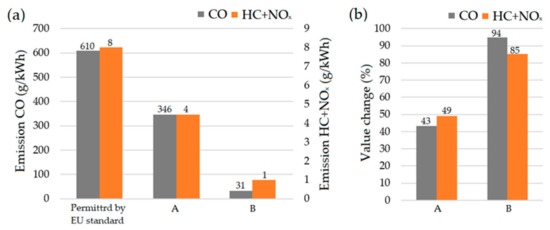
Figure 16.
Comparison of exhaust emissions of the designs tested with the exhaust emission limits in the European Union; (a) the emission limit value and the emissions during shredding processes; (b) the value of the difference between the emission limit value in the EU and that produced during shredding expressed as a percentage, where: A—gasoline fuel supply system, B—CNG fuel supply system.
Another effect of using CNG installations is a 32% reduction in fuel consumption (Figure 14). Such an effect is also noticeable by other scientists [72]. It is also often associated with the loss of power and torque characteristics (Figure 2), and dynamics of the examined drive unit [86,87]. In the analysed design, the authors observed a reduction of maximum power by 23% and torque by 15%. At the same time, these changes did not affect the shredding process and did not change the characteristics of the machine in the area of works and tests (the load due to the strength of the cutting mechanism was 20% lower than that allowed by the manufacturer, who expressed it in the diameter of the branches to be shredded and their hardness—hardwood species [61] to 100 mm in diameter). The reduction of fuel consumption after the use of CNG, and at the same time the reduction of power and torque of the engine, is related to the reduction of the volumetric efficiency of the CNG-fuelled engine, due to the greater share of air during CNG combustion (AFR CNG 17.2: 1, AFR gasoline 14.7:1). The lower fuel consumption expressed in g/s is reliable, but it is difficult to interpret the cost of machine use. Firstly, gasoline is sold in EUR/L (0.99 EUR/L in Poland on 11 November 2020 [88]), while CNG in EUR/m3 (0.71 EUR/m3 in Poland 11 November 2020 [89]). The authors made the necessary calculations to facilitate the interpretation of the machine operating costs resulting from fuel consumption and determined the hourly cost of machine operation for the system powered by gasoline at about 2.02 EUR/h, while during operation with CNG at 0.95 EUR/h. The operating cost of the wood chipper under test, resulting from fuel consumption, is 53% when running on CNG compared to using gasoline.
The cost of modernizing an engine is around EUR 247, with the average cost of a new engine at EUR 270 (Table 2), so it can almost double its value. However, on the other hand, with an 8 h operating mode and savings of about EUR 1 per hour, the financial outlay incurred may be returned after about 31 days. With the average cost of a machine of EUR 1300, the addition of modernisation costs will increase the cost of machine purchase by 19% and the modernisation performed will then constitute about 16% of the machine cost.
The adaptation of IC engines to combustion of gaseous fuels may become a contemporary scientific trend as to the use of biogas [90,91,92]. Biogas obtained from the decomposition of, e.g., sewage [93], organic municipal waste [94,95], animal faeces [96], agricultural and food industry waste [97,98] and plant materials [96,97,99], can be used by plants processing these materials to propel their machinery and equipment [100,101]. Biogas is a mixture of gases characterized by a varied composition, but it can be purified to bio-methane and then meet the quality standards of natural gas [102]. Biogas can be considered as a renewable energy source because the cycle of carbon in its production and consumption cycle is closed and does not involve net carbon dioxide emissions [103]. Such work may be carried out in the future. However, it should be noted that biogas may have a methane content that is half that of natural gas.
5. Conclusions
Small engine modernization, by changing the fuel supply system and the fuel itself to an alternative such as CNG, can bring both environmental and economic benefits. Comparative research of a wood chipper in urban areas with two fuel supply systems: gasoline and CNG, has shown that the use of CNG fuel has reduced the emission of harmful exhaust compounds: CO (by 81%), CO2 (by 26%), HC (57%). However, it has contributed to an increase in NOx emissions (by 45%). According to the authors, NOx emissions can be reduced by using hydrogen (H2) admixtures to CNG, but this requires new tests. The value of emissions from a CNG-powered unit was significantly lower than those allowed in the European Union (CO by 94%, HC+NOx by 85%), which may be a suggestion to the legislators to introduce more restrictive provisions. The engine after the application of CNG had lower power and torque, but this did not prevent the proper implementation of the shredding process. The CNG engine had a 32% lower fuel consumption expressed in g/s and, combined with the lower CNG fuel price, also had a lower hourly cost of machine operation resulting from the fuel price (by about 53%). The cost of upgrading a CNG engine has almost doubled its value. The system used in the wood chipper increased its purchase cost by 19%. However, with an 8 h operating mode and demonstrated lower exploration costs resulting from the modernization (about 1 EUR/hour), it is returned after about 30 days. Moreover, the reduction in fuel consumption and pollutant emissions affects the local environment (reduction of air pollution in urban areas, which are highly susceptible to exceeding the permissible levels of air pollution), global environment (reduction of the greenhouse effect) and machine operators, who are most vulnerable to the negative impact of combustion engines. The engine powered by CNG fuel in a wood chipper seems to be a favourable solution to be used in adaptive drive control systems [32,36], as it is characterised by relatively low HC emissions. On the other hand, the adaptive systems powered by gasoline reduce the emission of CO, CO2 and NOx, but emit more HC to the atmosphere [32].
Author Contributions
Validation, Ł.W., M.K. and P.L.; resources, Ł.W. and M.D.; methodology, Ł.W., M.D., P.L., M.K., F.M.; writing—original draft preparation, Ł.W., M.K. and P.L.; conceptualization, Ł.W., P.L. and M.K.; data curation, Ł.W.; software, Ł.W., M.D. and F.M.; investigation, Ł.W. and P.L.; formal analysis, Ł.W., M.K. and P.L.; visualization, Ł.W.; writing—review and editing, M.K., Ł.W.; supervision, Ł.W.; project administration, Ł.W.; funding acquisition, Ł.W. All authors have read and agreed to the published version of the manuscript.
Funding
Research was performed as part of the project “Interdisciplinary Dean’s Grant (IDG) of Poznan University of Technology” determined in the subject for the 2020 year–air quality in Poznan and how to improve it. Project title: “Design and research of mobile machines chipping wastes from urban agriculture processes for innovative construction solutions limiting the impact on the natural environment and machine operators” (33/32/SIGR/3334) financed by the Poznan University of Technology.
Conflicts of Interest
The authors declare no conflict of interest.
References
- EU. Directive 2014/94/EU of the European Parliament and of the Council of 22 October 2014 on the Deploy-Ment of Alternative Fuels Infrastructure Text with EEA Relevance; EU: Strasbourg, France, 2014. [Google Scholar]
- Dziewiatkowski, M.; Szpica, D.; Borawski, A. Evaluation of impact of combustion engine controller adaptation process on level of exhaust gas emissions in gasoline and compressed natural gas supply process. Eng. Rural Dev. 2020, 541–548. [Google Scholar] [CrossRef]
- Szpica, D. Research on the influence of LPG/CNG injector outlet nozzle diameter on uneven fuel dosage. Transport 2018, 33, 186–196. [Google Scholar] [CrossRef]
- Kuczyński, S.; Łaciak, M.; Szurlej, A.; Włodek, T. Impact of Liquefied Natural Gas Composition Changes on Methane Number as a Fuel Quality Requirement. Energies 2020, 13, 5060. [Google Scholar] [CrossRef]
- Merkisz, J.; Fuc, P.; Bajerlein, M.; Dobrzynski, M.; Rymaniak, Ł.; Ziółkowski, A. Reducing the Negative Impact of Public Transport on the Environment by Using CNG as a Fuel. J. KONBiN 2012, 22, 147–158. [Google Scholar] [CrossRef][Green Version]
- Quintili, A.; Castellani, B. The Energy and Carbon Footprint of an Urban Waste Collection Fleet: A Case Study in Central Italy. Recycling 2020, 5, 25. [Google Scholar] [CrossRef]
- Usman, M.; Hayat, N. Use of CNG and Hi-octane gasoline in SI engine: A comparative study of performance, emission, and lubrication oil deterioration. Energy Sources Part A Recover. Util. Environ. Eff. 2019, 1–15. [Google Scholar] [CrossRef]
- Evans, R.L.; Blaszczyk, J. A comparative study of the performance and exhaust emissions of a spark ignition engine fuelled by natural gas and gasoline. Proc. Inst. Mech. Eng. Part D J. Automob. Eng. 1997, 211, 39–47. [Google Scholar] [CrossRef]
- Ahmet, A.Y.; Yahya, D. Effects of equivalence ratio and CNG addition on engine performance and emissions in a dual sequential ignition engine. Int. J. Engine Res. 2019, 21, 1067–1082. [Google Scholar] [CrossRef]
- Ahmet, A.Y.; Yahya, D. Experimental and numerical investigation of effects of CNG and gasoline fuels on engine performance and emissions in a dual sequential spark ignition engine. Energy Sources Part A Recover. Util. Environ. Eff. 2018, 40, 2176–2192. [Google Scholar] [CrossRef]
- Bae, J.W.; Park, C.W.; Lee, J.W.; Kim, Y.R.; Kim, C.G.; Lee, S.Y.; Lee, J.W. A study on the full load operation characteristics and thermal efficiency of the 1.4L turbo CNG SI engine. J. Korean Inst. Gas 2018, 22, 34–39. [Google Scholar]
- Gonca, G.; Cakir, M.; Sahin, B. Performance characteristics and emission formations of a Spark Ignition (SI) engine fueled with different gaseous fuels. Arab. J. Sci. Eng. 2018, 43, 4487–4499. [Google Scholar] [CrossRef]
- Pan, J.; Wei, H.; Shu, G.Q.; Feng, D. Experimental study on combustion characteristics of methane/gasoline dual-fuel in a SI engine at different load conditions. SAE Tech. Paper 2018, 1–7. [Google Scholar] [CrossRef]
- Shamekhi, A.; Khatibzadeh, N.; Shamekhi, A.H. Performance and emissions characteristics investigation of a bi-fuel SI engine fuelled by CNG and gasoline. In Proceedings of the ASME Internal Combustion Engine Division Spring Technical Conference, 2006 Spring Technical Conference, Aachen, Germany, 7–10 May 2006; pp. 393–400. [Google Scholar] [CrossRef]
- Ou, X.; Zhang, X.; Zhang, X.; Zhang, Q. Life Cycle GHG of NG-Based Fuel and Electric Vehicle in China. Energies 2013, 6, 2644–2662. [Google Scholar] [CrossRef]
- Banaszkiewicz, T.; Chorowski, M.; Gizicki, W.; Jedrusyna, A.; Kielar, J.; Malecha, Z.; Piotrowska, A.; Polinski, J.; Rogala, Z.; Sierpowski, K.; et al. Liquefied Natural Gas in Mobile Applications—Opportunities and Challenges. Energies 2020, 13, 5673. [Google Scholar] [CrossRef]
- Saggu, M.H.; Sheikh, N.A.; Muhamad Niazi, U.; Irfan, M.; Glowacz, A.; Legutko, S. Improved Analysis on the Fin Reliability of a Plate Fin Heat Exchanger for Usage in LNG Applications. Energies 2020, 13, 3624. [Google Scholar] [CrossRef]
- Guo, H.; Zhou, S.; Zou, J.; Shreka, M. A Numerical Study on the Pilot Injection Conditions of a Marine 2-Stroke Lean-Burn Dual Fuel Engine. Processes 2020, 8, 1396. [Google Scholar] [CrossRef]
- Lindstad, E.; Eskeland, G.S.; Rialland, A.; Valland, A. Decarbonizing Maritime Transport: The Importance of Engine Technology and Regulations for LNG to Serve as a Transition Fuel. Sustainability 2020, 12, 8793. [Google Scholar] [CrossRef]
- Pelić, V.; Mrakovčić, T.; Radonja, R.; Valčić, M. Analysis of the Impact of Split Injection on Fuel Consumption and NOx Emissions of Marine Medium-Speed Diesel Engine. J. Mar. Sci. Eng. 2020, 8, 820. [Google Scholar] [CrossRef]
- Sui, C.; de Vos, P.; Stapersma, D.; Visser, K.; Ding, Y. Fuel Consumption and Emissions of Ocean-Going Cargo Ship with Hybrid Propulsion and Different Fuels over Voyage. J. Mar. Sci. Eng. 2020, 8, 588. [Google Scholar] [CrossRef]
- Stelmasiak, Z.; Larisch, J.; Pielecha, J.; Pietras, D. Particulate matter emission from dual fuel diesel engine fuelled with natural gas. Pol. Marit. Res. 2017, 24, 96–104. [Google Scholar] [CrossRef]
- Rimkus, A.; Stravinskas, S.; Matijošius, J. Comparative study on the energetic and ecologic parameters of dual fuels (diesel–NG and HVO–biogas) and conventional diesel fuel in a CI engine. Appl. Sci. 2020, 10, 359. [Google Scholar] [CrossRef]
- Gutarevych, Y.; Shuba, Y.; Matijošius, J.; Karev, S.; Sokolovskij, E.; Rimkus, A. Intensification of the combustion process in a gasoline engine by adding a hydrogen-containing gas. Int. J. Hydrogen Energy 2018, 43, 16334–16343. [Google Scholar] [CrossRef]
- Saaidia, R.; Jemni, M.A.; Abid, M.S. Simulation and Empirical Studies of the Commercial SI Engine Performance and Its Emission Levels When Running on a CNG and Hydrogen Blend. Energies 2018, 11, 29. [Google Scholar] [CrossRef]
- Park, B.Y.; Lee, K.-H.; Park, J. Conceptual Approach on Feasible Hydrogen Contents for Retrofit of CNG to HCNG under Heavy-Duty Spark Ignition Engine at Low-to-Middle Speed Ranges. Energies 2020, 13, 3861. [Google Scholar] [CrossRef]
- Regulation (EU). On Requirements for Emission Limit Values of Gaseous and Particulate Pollutants and Type-approval with Respect to Internal Combustion Engines for Mobile Machines Non-road, Amending Regulations (EU) No 1024/2012 and (EU) No 167/2013 and Amending and Repealing Directive 97/68/WE. No 2016/1628 of the European Parliament and of the Council of 14 September 2016. Off. J. Eur. Union. 2016, 252, 53–117. [Google Scholar]
- Waluś, K.J.; Warguła, Ł.; Krawiec, P.; Adamiec, J.M. Legal regulations of restrictions of air pollution made by non-road mobile machinery—The case study for Europe: A review. Environ. Sci. Pollut. Res. 2018, 25, 3243–3259. [Google Scholar] [CrossRef]
- Warguła, Ł. Innovative injection-ignition system in a non-road small engine—Construction system. In Proceedings of the 23rd International Scientific Conference, Palanga, Lithuania, 2–4 October 2019; pp. 931–935. [Google Scholar]
- Mahmoudzadeh Andwari, A.; Said, M.F.M.; Aziz, A.A.; Esfahanian, V.; Salavati-Zadeh, A.; Idris, M.A.; Perang, M.R.M.; Jamil, H.M. Design, modeling and simulation of a high-pressure gasoline direct injection (GDI) pump for small engine applications. J. Mech. Eng. 2018, 6, 107–120. [Google Scholar]
- Niinikoski, J.; Ewalds, J.; Heikkinen, E.; Kotilainen, J.; Kääriäinen, M.; Tammi, K.; Kiviluoma, P.; Korhonen, A.; Kuosmanen, P. Methods for reducing emissions of small internal combustion engines. In Proceedings of the 11th International DAAAM Baltic Conference, Industrial Engineering, Tallinn, Estonia, 20–22 April 2016. [Google Scholar]
- Warguła, Ł.; Kukla, M.; Lijewski, P.; Dobrzyński, M.; Markiewicz, F. Influence of Innovative Woodchipper Speed Control Systems on Exhaust Gas Emissions and Fuel Consumption in Urban Areas. Energies 2020, 13, 3330. [Google Scholar] [CrossRef]
- Warguła, Ł.; Wojtkowiak, D.; Waluś, K.J.; Krawiec, P.; Wieczorek, B. The analysis of the efficiency of the control system of wood chipper’s driver with spark-ignition engine based on Skoda combustion engine 1.459 kW. In Proceedings of the 21st International Scientific Conference, Juodkrante, Lithuania, 20–22 September 2017; pp. 452–458. [Google Scholar]
- Warguła, Ł.; Waluś, J.K.; Krawiec, P. Determination of working conditions of mobile chipping wood machines in the aspect of innovative drive control systems. Sylwan 2019, 163, 765–772. [Google Scholar]
- Warguła, Ł.; Kukla, M.; Krawiec, P.; Wieczorek, B. Impact of Number of Operators and Distance to Branch Piles on Woodchipper Operation. Forests 2020, 11, 598. [Google Scholar] [CrossRef]
- Warguła, Ł.; Krawiec, P.; Waluś, K.J.; Kukla, M. Fuel Consumption Test Results for a Self-Adaptive, Maintenance-Free Wood Chipper Drive Control System. Appl. Sci. 2020, 10, 2727. [Google Scholar] [CrossRef]
- Li, L.; Wang, Z.; Deng, B.; Han, Y.; Wang, H. Combustion and Emissions Characteristics of a Small Spark-Ignited LPG Engine. SAE Technical Paper 01-1738. 2002. Available online: https://www.sae.org/publications/technical-papers/content/2002-01-1738/ (accessed on 4 November 2020).
- Li, L.; Liu, Z.; Wang, H.; Deng, B.; Wang, Z.; Xiao, Z.; Su, Y.; Jiang, B. Development of a Gas-phase LPG Injection System for a Small SI Engine. SAE Technical Paper 01-3260. 2003. Available online: https://www.sae.org/publications/technical-papers/content/2003-01-3260/ (accessed on 4 November 2020).
- Sulaiman, M.Y.; Ayob, M.R.; Meran, I. Performance of single cylinder spark ignition engine fueled by LPG. Procedia Eng. 2013, 53, 579–585. [Google Scholar] [CrossRef]
- bin Mohd Zain, M.S.; bin Mohamed Soid, S.N.; bin Mior Abd Majid, M.F.; bin Zahelem, M.N. Performance characteristics of a small engine fueled by liquefied petroleum gas. In Advanced Engineering for Processes and Technologies; Ismail, A., Abu Bakar, M., Öchsner, A., Eds.; Advanced Structured Materials; Springer: Berlin, Germany; Cham, Germany, 2019; Volume 102, pp. 207–214. [Google Scholar]
- Sabariah, M.S.; Nabilah, A.S.; Rosli, A.B.; Junaidi, Z.Z.; Mustafar, M.T. Analysis and simulation of combustion and emission on small engine. In IOP Conference Series: Materials Science and Engineering; UMP Pekan: Pahang, Malaysia, 2019; Volume 469. [Google Scholar]
- Warguła, Ł.; Kukla, M.; Krawiec, P.; Wieczorek, B. Reduction in Operating Costs and Environmental Impact Consisting in the Modernization of the Low-Power Cylindrical Wood Chipper Power Unit by Using Alternative Fuel. Energies 2020, 13, 2995. [Google Scholar] [CrossRef]
- Warguła, Ł.; Kukla, M.; Lijewski, P.; Dobrzyński, M.; Markiewicz, F. Influence of the Use of Liquefied Petroleum Gas (LPG) Systems in Woodchippers Powered by Small Engines on Exhaust Emissions and Operating Costs. Energies 2020, 13, 5773. [Google Scholar] [CrossRef]
- Schirmer, W.N.; Olanyk, L.Z.; Guedes, C.L.B.; Quessada, T.P.; Ribeiro, C.B.; Capanema, M.A. Effects of air/fuel ratio on gas emissions in a small spark-ignited non-road engine operating with different gasoline/ethanol blends. Environ. Sci. Pollut. Res. 2017, 24, 20354–20359. [Google Scholar] [CrossRef]
- Ribeiro, C.B.; Martins, K.G.; Gueri, M.V.D.; Pavanello, G.P.; Schirmer, W.N. Effect of anhydrous ethanol/gasoline blends on performance and exhaust emissions of spark-ignited non-road engines. Environ. Sci. Pollut. Res. 2018, 25, 24192–24200. [Google Scholar] [CrossRef]
- Gong, C.; Li, Z.; Huang, K.; Liu, F. Research on the performance of a hydrogen/methanol dual-injection assisted spark-ignition engine using late-injection strategy for methanol. Fuel 2020, 260, 116403. [Google Scholar] [CrossRef]
- Warguła, Ł.; Waluś, K.J.; Krawiec, P.; Polasik, J. Electronic control injection-ignition systems in propulsion of non-road mobile machinery. J. Mech. Trans. Eng. 2018, 70, 61–78. [Google Scholar]
- Magagnotti, N.; Picchi, G.; Sciarra, G.; Spinelli, R. Exposure of mobile chipper operators to diesel exhaust. Ann. Occup. Hyg. 2014, 58, 217–226. [Google Scholar]
- Liška, S.; Safarik, D.; Klvač, R.; Kupcak, V.; Jirousek, R. General assessment of Jenz Hem 420 D chipper operating in the Czech Republic conditions. In Proceedings of the FORMEC 2010, Forest Engineering: Meeting the Needs of the Society and the Environment, Padova, Italy, 11–14 July 2010. [Google Scholar]
- Spinelli, R.; de Arruda Moura, A.C.; da Silva, P.M. Decreasing the diesel fuel consumption and CO2 emissions of industrial in-field chipping operations. J. Clean. Prod. 2018, 172, 2174–2181. [Google Scholar] [CrossRef]
- Wąs, A.; Sulewski, P.; Krupin, V.; Popadynets, N.; Malak-Rawlikowska, A.; Szymańska, M.; Skorokhod, I.; Wysokiński, M. The Potential of Agricultural Biogas Production in Ukraine—Impact on GHG Emissions and Energy Production. Energies 2020, 13, 5755. [Google Scholar] [CrossRef]
- Czarnecka-Komorowska, D.; Wiszumirska, K.; Garbacz, T. Films LDPE/LLDPE made from post–consumer plastics: Processing, structure, mechanical properties. Adv. Sci. Technol. Res. J. 2018, 12, 134–142. [Google Scholar] [CrossRef]
- Knitter, M.; Czarnecka-Komorowska, D.; Czaja-Jagielska, N.; Szymanowska-Powalowska, D. Manufacturing and Properties of Biodegradable Composites Based on Thermoplastic Starch/Polyethylene-Vinyl Alcohol and Silver Particles. In Advances in Manufacturing II. Volume 4—Mechanical Engineering; Gapinski, B., Szostak, M., Ivanov, V., Eds.; Springer: Berlin, Germany, 2019; pp. 610–624. [Google Scholar] [CrossRef]
- Czarnecka-Komorowska, D.; Wiszumirska, K. Sustainability design of plastic packaging for the Circular Economy. Polimery 2020, 65, 8–17. [Google Scholar] [CrossRef]
- Kuczyński, S.; Liszka, K.; Łaciak, M.; Olijnyk, A.; Szurlej, A. Experimental Investigations and Operational Performance Analysis on Compressed Natural Gas Home Refueling System (CNG-HRS). Energies 2019, 12, 4511. [Google Scholar] [CrossRef]
- Warguła, Ł.; Waluś, K.J.; Krawiec, P.; Kukla, M. Research of the ignition advance angle characteristics on the example of a German GX 390 combustion engine. Autobusy Technol. Eksploat. Syst. Transp. 2017, 12, 1387–1391. [Google Scholar]
- Merkisz, J.; Dobrzyński, M.; Kozak, M.; Lijewski, P.; Fuć, P. Environmental aspects of the use of cng in public urban transport. Altern. Fuels Technol. Environ. Cond. 2016, 1–22. [Google Scholar] [CrossRef]
- Dorosz, P. Compressed and liquefied natural gas as an alternative for petroleum derived fuels used in transport (original text in Polish: Sprężony i skroplony gaz ziemny jako alternatywa dla paliw ropopochodnych wykorzystywanych w transporcie). Polit. Energetyczna-Energy Policy J. 2018, 21, 85–98. [Google Scholar]
- Warowny, W.; Tkacz, A. Natural gas and its characteristics as fuel for wheeled vehicles (original text in Polish: Gaz ziemny i jego charakterystyka jako paliwa do pojazdów kołowych). Gaz Woda i Technika Sanitarna 2001, 75, 267–272. [Google Scholar]
- Wołoszyn, R. Natural gas as a vehicle fuel (original text in Polish: Gaz ziemny jako paliwo do napędu pojazdów). Eksploatacja i Niezawodność 2003, 3, 19–22. [Google Scholar]
- Warguła, Ł.; Kaczmarzyk, P.; Dziechciarz, A. The assessment of fire risk of non-road mobile wood chopping machines. J. Res. Appl. Agric. Eng. 2019, 64, 58–64. [Google Scholar]
- Bektas, I.; Alma, M.H.; As, N. Determination of the relationships between Brinell and Janka hardness of eastern beech (Fagus orientalis Lipsky). For. Prod. J. 2001, 51, 84. [Google Scholar]
- Green, D.W.; Begel, M.; Nelson, W. Janka Hardness Using Nonstandard Specimens; US Department of Agriculture, Forest Service, Forest Product Laboratory: Washington, DC, USA, 2006; p. 303.
- Krawiec, P. Analysis of selected dynamic features of a two-whwwled transmission system. J. Theor. Appl. Mech. 2017, 55, 461–467. [Google Scholar] [CrossRef]
- Krawiec, P.; Marlewski, A. Profile design of noncircular belt pulleys. J. Theor. Appl. Mech. 2016, 54, 561–570. [Google Scholar] [CrossRef]
- Krawiec, P.; Marlewski, A. Spline description of not typical gears for belt transmissions. J. Theor. Appl. Mech. 2011, 49, 355–367. [Google Scholar]
- Krawiec, P.; Pajtášová, M.; Meler, F.; Warguła, Ł. Testing functional features of V-belt transmissions. In IOP Conference Series: Materials Science and Engineering; UMP Pekan: Pahang, Malaysia, 2020; Volume 776, p. 012008. [Google Scholar] [CrossRef]
- Lijewski, P.; Fuć, P.; Markiewicz, F.; Dobrzański, M. Problems of exhaust emissions testing from machines and mobile devices in real operating conditions. Combust. Engines 2019, 179, 292–296. [Google Scholar]
- Warguła, Ł.; Kukla, M. Determination of m a ximum torque during carpentry waste comminution. Wood Res. 2020, 65, 771–784. [Google Scholar] [CrossRef]
- Warguła, Ł.; Adamiec, J.M.; Waluś, K.J.; Krawiec, P. The characteristics analysis of torque and rotation speed of working unit of branch grinder-introductory research. In MATEC Web of Conferences, Proceedings of the Machine Modelling and Simulations, Sklené Teplice, Slovak Republic, 5–8 September 2017; EDP Sciences: Lez Ili, France, 2018; Volume 157, p. 01021. [Google Scholar]
- Warguła, Ł.; Krawiec, P. The research on the characteristic of the cutting force while chipping of the Caucasian Fir (Abies Nordmanniana) with a single-shaft wood chipper. In IOP Conference Series: Materials Science and Engineering; UMP Pekan: Pahang, Malaysia, 2020; Volume 776, p. 012012. [Google Scholar] [CrossRef]
- Jahirul, M.I.; Masjuki, H.H.; Saidur, R.; Kalam, M.A.; Jayed, M.H.; Wazed, M.A. Comparative engine performance and emission analysis of CNG and gasoline in a retrofitted car engine. Appl. Therm. Eng. 2010, 30, 2219–2226. [Google Scholar] [CrossRef]
- Yasar, A.; Haider, R.; Tabinda, A.B.; Kausar, F.; Khan, M. A comparison of engine emissions from heavy, medium, and light vehicles for CNG, diesel, and gasoline fuels. Pol. J. Environ. Stud. 2013, 22, 1277–1281. [Google Scholar]
- Bielaczyc, P.; Szczotka, A.; Woodburn, J. A comparison of exhaust emissions from vehicles fuelled with petrol, LPG and CNG. In IOP Conference Series: Materials Science and Engineering; UMP Pekan: Pahang, Malaysia, 2016; Volume 148, p. 012060. [Google Scholar] [CrossRef]
- Zhang, C.H.; Xie, Y.L.; Wang, F.S.; Ma, Z.Y.; Qi, D.H.; Qiu, Z.W. Emission comparison of light-duty in-use flexible-fuel vehicles fuelled with gasoline and compressed natural gas based on the ECE 15 driving cycle. Proc. Inst. Mech. Eng. Part D J. Automob. Eng. 2011, 225, 90–98. [Google Scholar] [CrossRef]
- Merkisz, J.; Pielecha, J.; Gis, W.; Gis, M.; Jasiński, R. Comparative assessment of exhaust emission buses: Powered CNG and Diesel. Combust. Engines 2015, 162, 775–781. [Google Scholar]
- Alrazen, H.A.; Ahmad, K.A. HCNG fueled spark-ignition (SI) engine with its effects on performance and emissions. Renew. Sustain. Energy Rev. 2018, 82, 324–342. [Google Scholar] [CrossRef]
- Hu, E.; Huang, Z.; Zheng, J.; Li, Q.; He, J. Numerical study on laminar burning velocity and NO formation of premixed methane–hydrogen–air flames. Int. J. Hydrogen Energy 2009, 34, 6545–6557. [Google Scholar] [CrossRef]
- De Simio, L.; Gambino, M.; Iannaccone, S. Experimental and numerical study of hydrogen addition in a natural gas heavy duty engine for a bus vehicle. Int. J. Hydrogen Energy 2013, 38, 6865–6873. [Google Scholar] [CrossRef]
- Lim, G.; Lee, S.; Park, C.; Choi, Y.; Kim, C. Effect of ignition timing retard strategy on NOx reduction in hydrogen-compressed natural gas blend engine with increased compression ratio. Int. J. Hydrogen Energy 2014, 39, 2399–2408. [Google Scholar] [CrossRef]
- Lim, G.; Lee, S.; Park, C.; Choi, Y.; Kim, C. Effects of compression ratio on performance and emission characteristics of heavy-duty SI engine fuelled with HCNG. Int. J. Hydrogen Energy 2013, 38, 4831–4838. [Google Scholar] [CrossRef]
- Merkisz, J.; Pielecha, J.; Fuc, P.; Lijewski, P. The analysis of the PEMS measurements of the exhaust emissions from city buses using different research procedures. In Proceedings of the 2012 IEEE Vehicle Power and Propulsion Conference, Seoul, Korea, 9–12 October 2012; pp. 903–907. [Google Scholar]
- Merkisz, J.; Lijewski, P.; Fuc, P.; Siedlecki, M.; Ziolkowski, A. Development of the methodology of exhaust emissions measurement under RDE (Real Driving Emissions) conditions for non-road mobile machinery (NRMM) vehicles. In Proceedings of the IOP Conference Series: Materials Science and Engineering, Krakow, Poland, 22–23 September 2016; Volume 148. [Google Scholar] [CrossRef]
- Merkisz, J.; Lijewski, P.; Fuc, P.; Siedlecki, M.; Weymann, S. The use of the PEMS equipment for the assessment of farm fieldwork energy consumption. Appl. Eng. Agric. 2015, 31, 875–879. [Google Scholar]
- Lijewski, P.; Fuc, P.; Dobrzynski, M.; Markiewicz, F. Exhaust emissions from small engines in handheld devices. MATEC Web Conf. 2017, 118, 00016. [Google Scholar] [CrossRef]
- Romaniszyn, K.M. The dynamics of the acceleration of a car fuelled with petrol and CNG. Silniki Spalinowe 2006, 45, 67–72. [Google Scholar]
- Parczewski, K.; Romaniszyn, K.M.; Wnęk, H. A dynamic test of a vehicle in motion and exhaust gas emissions during alternative fuelling with gasoline and compressed natural gas (CNG). Silniki Spalinowe 2008, 47, 52–60. [Google Scholar]
- Gasoline Price. Available online: https://www.autocentrum.pl/stacje-paliw/pkn-orlen/ (accessed on 11 November 2020).
- CNG Price. Available online: http://pgnig.pl/cng (accessed on 11 November 2020).
- Nyamukamba, P.; Mukumba, P.; Chikukwa, E.S.; Makaka, G. Biogas Upgrading Approaches with Special Focus on Siloxane Removal—A Review. Energies 2020, 13, 6088. [Google Scholar] [CrossRef]
- Macor, A.; Benato, A. A Human Health Toxicity Assessment of Biogas Engines Regulated and Unregulated Emissions. Appl. Sci. 2020, 10, 7048. [Google Scholar] [CrossRef]
- Macor, A.; Benato, A. Regulated Emissions of Biogas Engines—On Site Experimental Measurements and Damage Assessment on Human Health. Energies 2020, 13, 1044. [Google Scholar] [CrossRef]
- Riley, D.M.; Tian, J.; Güngör-Demirci, G.; Phelan, P.; Villalobos, J.R.; Milcarek, R.J. Techno-Economic Assessment of CHP Systems in Wastewater Treatment Plants. Environments 2020, 7, 74. [Google Scholar] [CrossRef]
- Ciuła, J.; Kozik, V.; Generowicz, A.; Gaska, K.; Bak, A.; Paździor, M.; Barbusiński, K. Emission and Neutralization of Methane from a Municipal Landfill-Parametric Analysis. Energies 2020, 13, 6254. [Google Scholar] [CrossRef]
- Urbanowska, A.; Polowczyk, I.; Kabsch-Korbutowicz, M.; Seruga, P. Characteristics of Changes in Particle Size and Zeta Potential of the Digestate Fraction from the Municipal Waste Biogas Plant Treated with the Use of Chemical Coagulation/Precipitation Processes. Energies 2020, 13, 5861. [Google Scholar] [CrossRef]
- Ahmed, S.A.; Zhou, S.; Zhu, Y.; Tsegay, A.S.; Feng, Y.; Ahmad, N.; Malik, A. Effects of Pig Manure and Corn Straw Generated Biogas and Methane Enriched Biogas on Performance and Emission Characteristics of Dual Fuel Diesel Engines. Energies 2020, 13, 889. [Google Scholar] [CrossRef]
- Oreggioni, G.D.; Gowreesunker, B.L.; Tassou, S.A.; Bianchi, G.; Reilly, M.; Kirby, M.E.; Toop, T.A.; Theodorou, M.K. Potential for Energy Production from Farm Wastes Using Anaerobic Digestion in the UK: An Economic Comparison of Different Size Plants. Energies 2017, 10, 1396. [Google Scholar] [CrossRef]
- Zhang, Y.; Kusch-Brandt, S.; Heaven, S.; Banks, C.J. Effect of Pasteurisation on Methane Yield from Food Waste and Other Substrates in Anaerobic Digestion. Processes 2020, 8, 1351. [Google Scholar] [CrossRef]
- Kral, I.; Piringer, G.; Saylor, M.K.; Lizasoain, J.; Gronauer, A.; Bauer, A. Life Cycle Assessment of Biogas Production from Unused Grassland Biomass Pretreated by Steam Explosion Using a System Expansion Method. Sustainability 2020, 12, 9945. [Google Scholar] [CrossRef]
- Rosén, T.; Ödlund, L. System Perspective on Biogas Use for Transport and Electricity Production. Energies 2019, 12, 4159. [Google Scholar] [CrossRef]
- Owczuk, M.; Matuszewska, A.; Kruczyński, S.; Kamela, W. Evaluation of Using Biogas to Supply the Dual Fuel Diesel Engine of an Agricultural Tractor. Energies 2019, 12, 1071. [Google Scholar] [CrossRef]
- Benato, A.; Macor, A. Italian Biogas Plants: Trend, Subsidies, Cost, Biogas Composition and Engine Emissions. Energies 2019, 12, 979. [Google Scholar] [CrossRef]
- Smith, S. Waste Management and Minimization, in Waste Management and Minimization; Smith, S., Cheeseman, C., Blakey, N., Eds.; EOLSS: Paris, France, 2009. [Google Scholar]
Publisher’s Note: MDPI stays neutral with regard to jurisdictional claims in published maps and institutional affiliations. |
© 2020 by the authors. Licensee MDPI, Basel, Switzerland. This article is an open access article distributed under the terms and conditions of the Creative Commons Attribution (CC BY) license (http://creativecommons.org/licenses/by/4.0/).